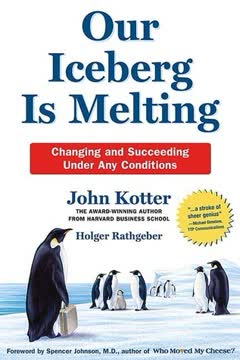Key Takeaways
1. Management and leadership are distinct but complementary forces
Management and leadership are very different in terms of actions, processes, and behavior.
Management ensures stability. It focuses on planning, organizing, and controlling resources to achieve specific goals efficiently. Management creates systems, processes, and structures that enable organizations to function smoothly on a day-to-day basis.
Leadership drives change. It involves setting a vision, inspiring others, and guiding the organization towards new possibilities. Leaders motivate people, foster innovation, and navigate uncertainty.
Key differences:
- Management: Maintaining order, executing plans, measuring results
- Leadership: Creating vision, inspiring action, driving innovation
Both are essential for organizational success, especially in complex environments facing rapid change.
2. Adaptability is crucial in a rapidly changing environment
We cannot just settle, each of us doing our daily work or doing it a little better, and hope for the best.
Embrace change as opportunity. Organizations that thrive in dynamic environments cultivate a culture of adaptability. This involves encouraging experimentation, learning from failures, and continuously seeking new solutions to emerging challenges.
Develop agile strategies. Rather than relying solely on rigid long-term plans, successful organizations maintain flexibility to pivot quickly when circumstances change. This requires:
- Regular environmental scanning
- Rapid prototyping and testing of new ideas
- Cross-functional collaboration to solve problems
- Empowering employees to make decisions and take calculated risks
3. Size and complexity demand different organizational approaches
With size comes . . .
Scale brings challenges. As organizations grow, they face increasing complexity in coordination, communication, and decision-making. What works for a small team often breaks down at larger scales.
Balance structure and flexibility. Large organizations need:
- Clear hierarchies and roles for efficiency
- Standardized processes for consistency
- Robust systems for tracking and accountability
However, they must also maintain:
- Channels for bottom-up innovation
- Decentralized decision-making where appropriate
- Flexibility to adapt to local conditions and emerging opportunities
The key is finding the right balance between management (for stability and efficiency) and leadership (for innovation and adaptability) as the organization grows.
4. Innovation and creativity thrive in supportive environments
You cannot fail here, unless you fail to try.
Foster psychological safety. Create an atmosphere where people feel safe to share ideas, take risks, and learn from failures. This involves:
- Encouraging open communication
- Celebrating creative thinking, even when ideas don't pan out
- Viewing mistakes as learning opportunities
Provide resources and autonomy. Support innovation by:
- Allocating time and resources for experimentation
- Empowering teams to pursue promising ideas
- Removing bureaucratic barriers to quick action
Examples of innovation-friendly practices:
- Google's "20% time" for personal projects
- 3M's "15% culture" encouraging experimentation
- Hackathons and innovation challenges
5. Effective leadership can emerge from unexpected places
Many of their new successes were seemingly small and relatively easy to do. But small adds up if it keeps coming and coming.
Cultivate distributed leadership. Recognize that valuable ideas and initiatives can come from anywhere in the organization, not just the top. Encourage and support leadership at all levels by:
- Providing opportunities for employees to lead projects or teams
- Offering leadership development programs across the organization
- Recognizing and rewarding initiative-taking
Create channels for bottom-up innovation. Establish formal and informal pathways for ideas to flow upward and across the organization:
- Idea submission platforms
- Cross-functional innovation teams
- Regular town halls or open forums with leadership
By tapping into the collective intelligence and creativity of the entire workforce, organizations can unlock new sources of innovation and adaptability.
6. Balancing structure and flexibility is key to organizational success
To have a clan like ours function reliably, you foremost need discipline and order.
Establish a strong foundation. Create clear structures, processes, and roles to ensure efficiency and consistency in core operations. This provides stability and enables the organization to scale effectively.
Build in flexibility. Within this framework, incorporate mechanisms for adaptation and innovation:
- Empowered cross-functional teams
- Rapid decision-making processes
- Continuous feedback loops
Key areas to balance:
- Centralization vs. decentralization
- Standardization vs. customization
- Planning vs. improvisation
- Control vs. autonomy
The goal is to create an organization that is both stable and agile, capable of executing reliably while also adapting quickly to change.
7. Urgency and passion drive meaningful change
Is the clan thriving and growing? How well did it deal with the sandstorm crisis? Are you sleeping well at night knowing that your friends are safe? Is the clan living up to your hopes and dreams?
Create a sense of urgency. Help people understand why change is necessary and important. This involves:
- Clearly communicating the challenges and opportunities facing the organization
- Painting a compelling picture of the consequences of inaction
- Highlighting early wins to build momentum
Tap into intrinsic motivation. Connect change initiatives to people's deeper values and aspirations. When people are passionate about a cause, they'll go above and beyond to make it succeed.
Ways to build urgency and passion:
- Share customer stories and feedback
- Organize site visits or immersive experiences
- Celebrate progress and recognize contributions
- Connect organizational goals to personal growth and meaning
8. Shared vision and purpose unite and motivate teams
We all care for our fellow Meerkats too much to ever put them again at risk of sudden attacks and starvation, or possibly worse.
Craft a compelling vision. Develop and communicate a clear, inspiring picture of the future you're working towards. This provides direction and meaning to people's efforts.
Connect to a higher purpose. Help people understand how their work contributes to something larger than themselves. This taps into intrinsic motivation and builds commitment.
Elements of an effective shared vision:
- Aspirational yet achievable
- Aligned with organizational values
- Relevant to all stakeholders
- Clearly articulated and frequently reinforced
When teams rally around a common vision and purpose, they're more likely to collaborate effectively and persevere through challenges.
9. Small wins build momentum for larger transformations
It was one more unprecedented action, since regular Kats did not invite bosses to anything. But many of the bosses did come, including Moro, who arrived early.
Start with quick wins. Begin change initiatives with small, achievable projects that demonstrate value quickly. This builds confidence, credibility, and momentum for larger transformations.
Celebrate and communicate successes. Widely share the results of successful initiatives, no matter how small. This:
- Reinforces the benefits of change
- Encourages others to get involved
- Builds a track record of success
Strategies for generating quick wins:
- Pilot projects in receptive areas of the organization
- Focus on high-visibility, low-risk improvements
- Empower front-line employees to implement immediate enhancements
By accumulating small victories, organizations can overcome initial resistance and build support for more ambitious changes.
10. Continuous learning and improvement are essential for growth
If we need different results, are we going to get them by doing what we have always done, but just working harder?
Foster a learning culture. Encourage curiosity, experimentation, and reflection throughout the organization. This involves:
- Allocating time and resources for learning and development
- Encouraging knowledge sharing across teams and departments
- Viewing failures as learning opportunities
Implement feedback loops. Create systems to gather and act on information about performance and results:
- Regular review and retrospective meetings
- Customer feedback mechanisms
- Data-driven decision-making processes
Key practices for continuous improvement:
- After-action reviews
- Kaizen events
- Cross-functional problem-solving teams
- Benchmarking against industry best practices
By constantly seeking to learn and improve, organizations can stay ahead of changing conditions and continuously enhance their capabilities.
Last updated:
FAQ
What's "That's Not How We Do It Here!" about?
- Fable Format: The book is a fable about a clan of Meerkats facing challenges due to environmental changes and internal organizational issues.
- Organizational Dynamics: It explores how organizations rise, fall, and can rise again by balancing management and leadership.
- Main Characters: The story follows characters like Matt, Nadia, and Ayo as they navigate these challenges and seek solutions.
- Core Message: It emphasizes the need for both management and leadership to adapt to rapid changes and ensure organizational success.
Why should I read "That's Not How We Do It Here!"?
- Practical Insights: The book provides practical insights into organizational behavior and change management through an engaging narrative.
- Relatable Story: The fable format makes complex concepts accessible and relatable, offering a fresh perspective on leadership and management.
- Real-World Application: It offers lessons that can be applied to real-world organizational challenges, making it valuable for leaders and managers.
- Engaging and Thought-Provoking: The story is designed to be thought-provoking and engaging, encouraging readers to reflect on their own organizational experiences.
What are the key takeaways of "That's Not How We Do It Here!"?
- Balance of Leadership and Management: Successful organizations need both strong management for reliability and leadership for innovation.
- Adaptability to Change: Organizations must be agile and adaptable to survive and thrive in rapidly changing environments.
- Empowerment and Engagement: Encouraging leadership at all levels and engaging employees can lead to innovative solutions and organizational growth.
- Dual Structure: A dual system combining management and leadership can help organizations handle complexity and change effectively.
How do the Meerkats in "That's Not How We Do It Here!" represent organizational challenges?
- Symbolic Characters: The Meerkats symbolize different roles and challenges within an organization, such as leadership, management, and innovation.
- Environmental Challenges: The clan faces external threats like predators and drought, representing market and environmental changes.
- Internal Struggles: Internal conflicts and resistance to change highlight common organizational issues like rigidity and lack of innovation.
- Journey of Discovery: The characters' journey to find better solutions mirrors the process of organizational learning and adaptation.
What is the significance of the title "That's Not How We Do It Here!"?
- Resistance to Change: The title reflects a common organizational mindset that resists change and innovation.
- Challenge to Status Quo: It highlights the need to challenge traditional ways of thinking and embrace new approaches.
- Cultural Barriers: The phrase represents cultural barriers that can hinder progress and adaptation in organizations.
- Call for Innovation: It serves as a call to action for organizations to innovate and adapt to survive and thrive.
What are the best quotes from "That's Not How We Do It Here!" and what do they mean?
- "The vultures had mysteriously turned from scavengers to killers." This quote symbolizes unexpected external threats that can destabilize an organization.
- "You first learn the rules, then..." It emphasizes the importance of understanding existing systems before innovating or changing them.
- "In the center, we have the group that comes together weekly to talk about what we stand for." This highlights the importance of shared vision and values in driving organizational success.
- "We cannot just settle, each of us doing our daily work or doing it a little better, and hope for the best." It underscores the need for proactive change and innovation rather than complacency.
How does "That's Not How We Do It Here!" define leadership and management?
- Distinct Roles: Leadership and management are defined as distinct roles with different functions and outcomes.
- Leadership: Involves inspiring, motivating, and guiding people towards innovation and change.
- Management: Focuses on planning, organizing, and ensuring reliability and efficiency in daily operations.
- Complementary Functions: Both are essential for organizational success, especially in complex and changing environments.
What is the dual system proposed in "That's Not How We Do It Here!"?
- Combination of Structures: The dual system combines traditional management structures with a network-like leadership system.
- Management for Stability: Ensures reliability and efficiency in handling daily operations and complex systems.
- Leadership for Agility: Provides the agility and innovation needed to respond to rapid changes and new opportunities.
- Integration of Both: The system allows organizations to benefit from both stability and adaptability, crucial for long-term success.
How does "That's Not How We Do It Here!" address the challenges of organizational growth?
- Growth and Complexity: The book discusses how growth can lead to increased complexity and challenges in maintaining efficiency and innovation.
- Need for Structure: As organizations grow, structured management becomes essential to handle routine tasks reliably.
- Innovation and Adaptation: Leadership is needed to foster innovation and adapt to new challenges that come with growth.
- Balancing Act: The book emphasizes the need to balance management and leadership to sustain growth and success.
What lessons can businesses learn from "That's Not How We Do It Here!"?
- Embrace Change: Businesses should embrace change and be willing to adapt to new circumstances and challenges.
- Foster Innovation: Encouraging innovation and leadership at all levels can lead to creative solutions and competitive advantage.
- Build a Dual System: Implementing a dual system of management and leadership can help businesses navigate complexity and change.
- Engage Employees: Engaging employees and empowering them to take initiative can drive organizational success and resilience.
How does "That's Not How We Do It Here!" illustrate the importance of culture in organizations?
- Cultural Resistance: The book highlights how cultural resistance to change can hinder progress and innovation.
- Shared Vision: A strong, shared vision and values are crucial for aligning efforts and driving organizational success.
- Cultural Transformation: Transforming organizational culture to embrace change and innovation is essential for long-term success.
- Role of Leadership: Leadership plays a key role in shaping and transforming organizational culture to support growth and adaptation.
What practical steps does "That's Not How We Do It Here!" suggest for implementing change?
- Create Urgency: Establish a sense of urgency around opportunities and challenges to motivate change.
- Build Coalitions: Form diverse groups that span silos and levels to guide and coordinate change efforts.
- Communicate Relentlessly: Communicate initiatives and successes to build momentum and engage more people.
- Celebrate Wins: Celebrate small and big wins to reinforce progress and sustain motivation for change.
Review Summary
That's Not How We Do It Here! receives mixed reviews, with an average rating of 3.84/5. Readers appreciate its insights on balancing management and leadership in organizations, particularly during times of change. The book uses a fable about meerkats to illustrate its concepts, which some find engaging and others find unnecessary. Many praise the book's lessons on adapting to change and fostering innovation, while some critics feel the content is not novel. The book's brevity and accessibility are generally viewed positively.
Similar Books










Download PDF
Download EPUB
.epub digital book format is ideal for reading ebooks on phones, tablets, and e-readers.










